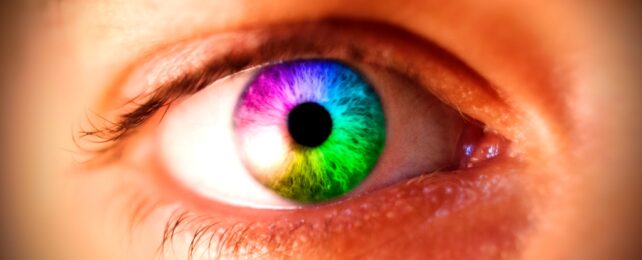Certain smells can change the way that you perceive color, according to recent experiments in the United Kingdom.
The effects are so subtle, however, that you've probably never even noticed them. Scientists themselves are still far from identifying all the various ways our senses can overlap and interact.
The human senses are often treated like a handful of distinct entities, and yet that's far from the truth. In reality, everyone has some level of sensory 'crossover' – even those of us who can't 'taste' color or 'hear' shapes like synesthetes.
If a cherry soda is colored orange, for instance, your eyes can trick you into tasting an orange flavor, and if a strawberry beverage is colored extra red, your nose may detect a sweeter fragrance.
The way that color changes our perception of taste is well-studied, but the way these hues interact with smell is not nearly as well understood.
Research by a team from three UK universities has now uncovered a strange way that smell can color our perception of reality.
In the experiment, 24 adult participants of both sexes were positioned in a dark room in front of a computer screen. For four minutes, an air purifier cleaned the air. An odor was then diffused into the space for five minutes.
The participant waiting in the room was never explicitly told about the fragrance, only that they were going to see a color patch pop up on the screen in front of them. Their goal was to toggle two sliders – one that went from yellow to blue and the other that went from green to red – to turn the color patch neutral gray.
This same process was repeated until all participants had smelled four odors five times apiece while adjusting the color patches. The odors were randomly chosen from a list that included caramel, cherry, coffee, lemon, and peppermint. Odorless water was used as a control for every participant.
The authors of the study found that participants had a weak tendency to adjust the sliders too far away from neutral gray when a scent was diffused as opposed to odorless water.
The odor appeared to bias the participant's perception of neutral grey, angling its color towards their "respective odor-color correspondences", usually by making the grey 'warmer' in some way.
When the odor of coffee wafted through the room, for example, participants appeared to 'see' grey with a slightly redder-brown hue.
Caramel, on the other hand, had participants choosing a yellower grey than neutral grey.
"These results show that the perception of grey tended towards their anticipated crossmodal correspondences for four out of five scents, namely lemon, caramel, cherry, and coffee," explains cognitive psychologist Ryan Ward from Liverpool John Moores University.
"This 'overcompensation' suggests that the role of crossmodal associations in processing sensory input is strong enough to influence how we perceive information from different senses, here between odors and colors."
Ward and his colleagues have long been interested in figuring out how smell and sight interact.
Each second, the human brain is working to integrate sensory information to make sense of the surrounding world. Smell is ingrained in our lives, and yet it often sneaks by our notice, tinging our perception without us even realizing it.
Previous studies have shown, for instance, that the nose can sometimes 'smell' what the eyes 'see' and vice versa. In these past experiments, participants experienced a series of dots on a computer screen as moving faster when the scent of lemon was present and slower when the scent of vanilla was present.
Like movement, color is also impacted by smell.
In a previous study, Ward and his colleagues found that the smell of caramel is associated with dark brown and yellow, whereas coffee is linked to dark brown and red, cherry is linked to pink, red, and purple, peppermint is linked to green and blue, and lemon is linked to yellow, green, and pink.
Their current experiment elaborates on those cross-modal associations, although the smell of peppermint did not seem to have an impact on the perception of grey, as the authors hypothesized it would.
More work among larger cohorts is needed to figure out why only some smells seem to have an effect on color perception.
"We need to know the degree to which odors influence color perception," argues Ward.
"For example, is the effect shown here still present for less commonly encountered odors, or even for odors encountered for the first time?"
Like much to do with smell, 'the most underrated sense', scientists are yet to find out.
The study was published in Frontiers in Psychology.
